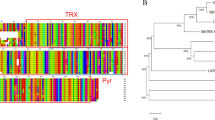Abstract
Ascorbate peroxidases are directly involved in reactive oxygen species (ROS) scavenging by reducing hydrogen peroxide to water. The tomato thylakoid-bound ascorbate peroxidase gene (StAPX) was introduced into tobacco. RNA gel blot analysis confirmed that StAPX in tomato leaves was induced by methylviologen-mediated oxidative stress. The sense transgenic seedlings exhibited higher tAPX activity than that of the wild type (WT) plants under oxidative stress conditions, while the antisense seedlings exhibited lower tAPX activity. Lower APX activities of antisense transgenic seedlings caused higher malondialdehyde contents and relative electrical conductivity. The sense transgenic seedlings with higher tAPX activity maintained higher chlorophyll content and showed the importance of tAPX in maintaining the optimal chloroplast development under methylviologen stress conditions, whereas the antisense lines maintained lower chlorophyll content than WT seedlings. Results indicated that the over-expression of StAPX enhanced tolerance to methylviologen-mediated oxidative stress in sense transgenic tobacco early seedlings, whereas the suppression of StAPX in antisense transgenic seedlings showed high sensitivity to oxidative stress.
Similar content being viewed by others
References
Aebi, H., 1974. Catalases. In: HU, B. (Ed.), Methods of Enzymatic Analysis. Academic Press, New York, p.673–677.
Amako, K., Chen, G.X., Asada, K., 1994. Separate assays specific for ascorbate peroxidase and guaiacol peroxidase and for the chloroplastic and cytosolic isozymes of ascorbate peroxidase in plants. Plant Cell Physiol., 35(3): 497–504.
Asada, K., 1999. The water-water cycle in chloroplasts: scavenging of active oxygens and dissipation of excess photons. Annu. Rev. Plant Physiol. Plant Mol. Biol., 50:601–639. [doi:10.1146/annurev.arplant.50.1.601]
Bradford, M.M., 1976. A rapid and sensitive method for the quantitation of microgram quantities of protein utilizing the principle of protein-dye binding. Anal. Biochem., 72:248–254. [doi:10.1016/0003-2697(76)90527-3]
Cornic, G., Bukhov, N.G., Wiese, C., Bligny, R., Heber, U., 2000. Flexible coupling between light-dependent electron and vectorial proton transport in illuminated leaves of C3 plants. Role of photosystem I-dependent proton pumping. Planta, 210(3):468–477. [doi:10.1007/PL00008154]
Danna, C.H., Bartoli, C.G., Sacco, F., Ingala, L.R., Santa-Maria, G.E., Guiamet, J.J., Ugalde, R.A., 2003. Thylakoid-bound ascorbate peroxisidase mutant exhibits impaired electron transport and photosynthetic activity. Plant Physiol., 132(4):2116–2125. [doi:10.1104/pp.103.021717]
Giacomelli, L., Masi, A., Ripoll, D.R., Lee, M.J., van Wijk, K.J., 2007. Arabidopsis thaliana deficient in two chloroplast ascorbate peroxidase shows accelerated light-induced necrosis when levels of cellular ascorbate are low. Plant Mol. Biol., 65(5):627–644. [doi:10.1007/s11103-007-9227-y]
Giannopolitis, C.N., Ries, S.K., 1977. Superoxide dismutases. I. Occurrence in higher plants. Plant Physiol., 59(2): 309–314. [doi:10.1104/pp.59.2.309]
Hemavathi, Upadhyaya, C.P., Akula, N., Young, K.E., Chun, S.C., Kim, D.H., Park, S.W., 2010. Enhanced ascorbic acid accumulation in transgenic potato confers tolerance to various abiotic stresses. Biotechnol. Lett., 32(2): 321–330. [doi:10.1007/s10529-009-0140-0]
Ishikawa, T., Shigeoka, S., 2008. Recent advances in ascorbate biosynthesis and the physiological significance of ascorbate peroxidase in photosynthesizing organisms. Biosci. Biotechnol. Biochem., 72(5):1143–1154. [doi:10.1271/bbb.80062]
Kampfenkel, K., van Montagu, M., Inzé, D., 1995. Extraction and determination of ascorbate and dehydroascorbate from plant tissue. Anal. Biochem., 225(1):165–167. [doi:10.1006/abio.1995.1127]
Kurepa, J., Smalle, J., van Montagu, M, Inzé, D., 1998. Oxidative stress tolerance and longevity in Arabidopsis: the late flowering mutant gigantea is tolerant to paraquat. Plant J., 14(6):759–764. [doi:10.1046/j.1365-313x.1998.00168.x]
Lee, Y.P., Kim, S.H., Bang, J.W., Lee, H.S., Kwak, S.S., Kwon, S.Y., 2007. Enhanced tolerance to oxidative stress in transgenic tobacco plants expressing three antioxidant enzymes in chloroplasts. Plant Cell Rep., 26(5):591–598. [doi:10.1007/s00299-006-0253-z]
Mano, J., Ohno, C., Domae, Y., Asada, K., 2001. Chloroplastic ascorbate peroxidase is the primary target of methylviologen-induced photooxidative stress in spinach leaves: its relevance to monodehydroascorbate radical detected with in vivo ESR. Biochim. Biophys. Acta, 1504(2-3): 275–287. [doi:10.1006/jsre.1998.5402]
Mittler, R., 2002. Oxidative stress, antioxidants and stress tolerance. Trends Plant Sci., 7(9):405–410. [doi:10.1016/S1360-1385(02)02312-9]
Murashige, T., Skoog, F., 1962. A revised medium for rapid growth and bio assay with tobacco tissue cultures. Physiol. Plant, 15(3):473–497. [doi:10.1111/j.1399-3054.1962.tb08052.x]
Nishiyama, Y., Allakhverdiev, S.I., Murata, N., 2006. A new paradigm for the action of reactive oxygen species in the photoinhibition of photosystem II. Biochim. Biophys. Acta, 1757(7):742–749. [doi:10.1016/j.bbabio.2006.05.013]
Noctor, G., Foyer, C.H., 1998. Ascorbate and glutathione: keeping active oxygen under control. Annu. Rev. Plant Physiol. Plant Mol. Biol., 49:249–279. [doi:10.1146/annurev.arplant.49.1.249]
Sato, Y., Masuta, Y., Saito, K., Murayama, S., Ozawa, K., 2011. Enhanced chilling tolerance at the booting stage in rice by transgenic overexpression of the ascorbate peroxidase gene, OsAPXa. Plant Cell Rep., 30(3):399–406. [doi:10.1007/s00299-010-0985-7]
Saxena, S.C., Joshi, P.K., Grimm, B., Arora, S., 2011. Alleviation of ultraviolet-C-induced oxidative damage through overexpression of cytosolic ascorbate peroxidase. Biologia, 66(6):1052–1059. [doi:10.2478/s11756-011-0120-4]
Shigeoka, S., Ishikawa, T., Tamoi, M., Miyagawa, Y., Takeda, T., Yabuta, Y., Yoshimura, K., 2002. Regulation and function of ascorbate peroxidase isoenzymes. J. Exp. Bot., 53(372):1305–1319. [doi:10.1093/jexbot/53.372.1305]
Sui, N., Li, M., Zhao, S.J., Li, F., Liang, H., Meng, Q.W., 2008. Overexpression of glycerol-3-phosphate acyltransferase gene improves chilling tolerance in tomato. Planta, 226(5):1097–1108. [doi:10.1007/s00425-007-0554-7]
Sun, W.H., Duan, M., Shu, D.F., Yang, S., Meng, Q.W., 2010. Over-expression of StAPX in tobacco improves seed germination and increases early seedling tolerance to salinity and osmotic stresses. Plant Cell Rep., 29(8): 917–926. [doi:10.1007/s00299-010-0878-9]
Yabuta, Y., Motoki, T., Yoshimura, K., Takeda, T., Ishikawa, T., Shigeoka, S., 2002. Thylakoid membrane-bound peroxidase is a limiting factor of antioxidative systems under photo-oxidative stress. Plant J., 32(6):915–925. [doi:10.1046/j.1365-313X.2002.01476.x]
Yoshimura, K., Miyao, K., Gaber, A., Takeda, T., Kanaboshi, H., Miyasaka, H., Shigeoka, S., 2004. Enhancement of stress tolerance in transgenic tobacco plants overexpressing Chlamydomonas glutathione peroxidase in chloroplasts or cytosol. Plant J., 37(1):21–33. [doi:10.1046/j.1365-313X.2003.01930.x]
Author information
Authors and Affiliations
Corresponding author
Additional information
Project supported by the Natural Science Foundation of Jiangsu Province (No. BK2010344), the Opening Foundation of State Key Laboratory of Crop Biology (No. 2011KF11), the Postdoctoral Science Foundation of China (No. 2011M500867), and the National Natural Science Foundation of China (No. 31071338)
Rights and permissions
About this article
Cite this article
Sun, Wh., Wang, Y., He, Hg. et al. Reduction of methylviologen-mediated oxidative stress tolerance in antisense transgenic tobacco seedlings through restricted expression of StAPX . J. Zhejiang Univ. Sci. B 14, 578–585 (2013). https://doi.org/10.1631/jzus.B1200190
Received:
Accepted:
Published:
Issue Date:
DOI: https://doi.org/10.1631/jzus.B1200190




